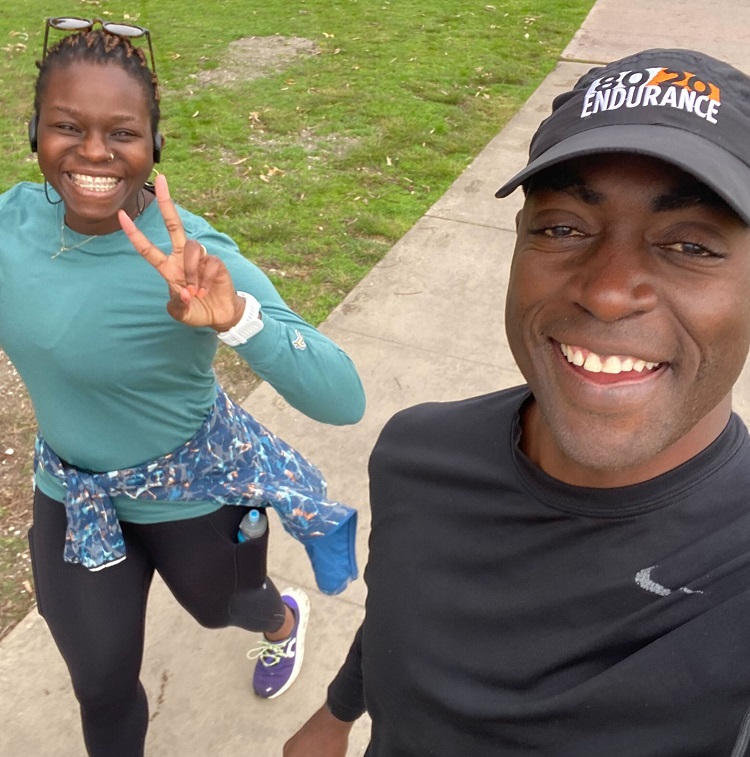Do you ever pass a runner that’s walking and assume they must be injured or in pain? Then a few miles later they pass you…then start walking again…what on Earth is going on?! You’ve likely heard of the run/walk method, but maybe you’re of the mindset that it’s just for beginners or not for serious runners. Wrong.

After talking to many runners and coaches, I’d beg to differ. What’s behind this run/walk method that has made it so popular?
Let’s take a look…
According to Jeff Galloway, the one who popularized the run walk method:
“Walk breaks will significantly speed up recovery because there is less damage to repair. The early walk breaks erase fatigue, and the later walk breaks will reduce or eliminate overuse muscle breakdown.”
Important to note this is not the walk once you get tired method, this is the run-walk the entire time method to help prevent that feeling of fatigue. During the walk breaks your body creates endorphins that allow you both mentally and physically to recover.
What is the Galloway Method?
While Galloway is certainly not the first to utilize run-walk, he has made it popular and “acceptable”. Showing that his method of interval running reduces overall impact on the body allowing many people to run farther and/or faster.
For those who have been asking me more about Low Heart Rate training tips to build your base, improve your endurance and stop feeling so fatigued, this style of training can help to initially make that transition.
Here are some keys to run/walk method of training:
- Basic: Every run is a combo of a run followed by a walk interval and repeat
- Interspersing intervals of walking and running, you can avoid injury and fatigue
- Don’t split up the long run – it’s about practicing time on your feet
- Doesn’t promote cross training, except aqua jogging
- 3 days of run-walk and one day of walking
- Very little speed work in the basic plans
I love this program because you can customize it to where you’re at! And if you aren’t yet having luck with running, checkout this article on walking a marathon.
Yes, you can walk the entire thing!
The goal of run/walk training is to help you build endurance without breaking down your body, creating injuries or shooting your cortisol super high because your workouts are too hard.

Select Your Run/Walk Pace
One key element of the program is running a “magic mile” to determine the appropriate training pace for your workouts.
Perform by running a hard mile and then using this formula {read complete instructions for the Magic Mile test}:
- Add 33 seconds for your pace for a 5K
- Multiply by 1.15 for 10K pace
- Multiply by 1.2 for half marathon pace
- Multiply by 1.3 for marathon pace
Run-walk ratio guideline as provided by Galloway {run:walk} in minutes unless otherwise noted. The run walk intervals will change you as you decide what feels best for you. Many runners start with the 1:1 ratio and move all the way to 8:1.
- 8 min/mi—4: 35 seconds
- 9 min/mi— 4: 1
- 10 min/mi—-3:1
- 11 min/mi—2:30-1
- 12 min/mi—-2:1
- 13 min/mi—-1:1
- 14 min/mi—30 sec run/30 sec walk
- 15 min/mi—30 sec/45 sec
- 16 min/mi—30 sec/60 sec
Magic Mile for Paces
Jeff Galloway training has come up with a calculator from his Magic Mile. Where you do a solid warm up and then run your hardest mile and use that time to calculate your paces. (How to do a Magic Mile Time Trial.)
5k pace: Add 33 seconds to your magic mile
10k pace: Multiply your magic mile time by 1.15
Half: Multiply your magic mile time by by 1.2
Marathon: Multiply your magic mile time by by 1.3
5 Easy Tips to Implement Run Walk for Marathon Training
As a running coach, we often utilize Galloway marathon training with our runners, by incorporating planned walk breaks. But rather than just using a static paper plan, we’re making adjustments and constantly seeing what is working.
I breakdown the EXACT steps to implement the run walk run method in a more detailed article. Because you’ll need to adjust your intervals over time.
The other MUST DO is adding in strength training for runners!!! He doesn’t include that in his plans, but it’s a must.
1. Set Up Your Watch
Utilizing a basic GPS watch like the Garmin Forerunner can make this process easier
Set your watch to beep or vibrate on each interval. This allows you to focus on the run without constantly checking the time
2. Be Consistent
If you really want to see progress, then it means sticking to the plan and to your commitment to run walk. If you go hard and run straight through some days, but that leaves you sore or exhausted then you might feel good in the moment, but actually be slowing your progress.
Remember that just showing up day after day is the biggest piece of getting better.
3. Enjoy Your Group, But Do Your Thing
If running with a group, just do your thing, don’t worry about others. We actually have a lot of folks that we coach 1:1 who enjoy the connection of meeting up with a group before and after, but during just plan to go their own speed and get what they need from the miles.
There is no judgement in that! It’s smart running.
And the group is a great way to build some accountability in to your training.
4. Remember To Walk Fast
Focus on power walking!! This is going to help your overall pace and endurance.
When you transition from run to walk, it’s not a leisurely stroll. You are still in the middle of the workout and need to keep thinking of this time as your workout.
5. Don’t Skip the Fueling
Remember that you need to fuel, no matter your pace. Checkout these energy gels to start practicing.
Often I see newer runners or those who call themselves slow think that because they aren’t going as fast they don’t need to fuel. Nope, sorry, just not true.
Fueling might actually be more important for you because you’re out there longer! Without those carbohydrates and electrolytes, you’re going to run out of energy or the body is going to try making it from something else…which is often muscle and not fat like you’d hope.
While these are the basic guidelines, I think this is a lot about testing what works best for you.
Training in Miami, the majority of marathon runners there used this to combat the heat and over time, many transitioned to roughly a 1 minute walk per mile.
Since a lot of them ran 7, 8 or 9 minute miles that meant a ratio of 6:1 or 7:1. Play with it to find the rhythm that feels best.

Run Walk Training Plan
If you’re trying to figure out how to put together a training plan for the run/walk method, honestly it’s pretty much the same as all beginner marathon plans.
You’re still focusing on the same long runs, weekly speed workouts and cross training. You’re just utilizing a slightly different pacing tool than you will with other programs like the Hanson method.
I have created a number of plans that work with the run/walk method, which you can find here:
- Printable Couch to 5K training plan
- Printable Couch to 10K training plan
- Printable Couch to Half Marathon training plan
- Printable Couch to Marathon training plan
It’s not that you need to start from the couch, these all just came together by request!
Additional Resources:
- Low Heart Rate Training Plans
- Website – Galloway’s website has a ton of information
- Book – The Run-walk-run Method by Jeff Galloway
- Benefits of adding a walk to marathon training
- Tips for Heavier Runners
Run Disney Galloway Plans
Recently I was asked to review the Galloway plans for the RunDisney marathons and have to admit I wasn’t a fan. I feel like his original plans all made sense for building, but when I see a week that involves three runs of 3 miles and then a 26 mile run my brain exploded a little.
As noted, he is a well versed coach who has worked with tons of runners. He may have seen benefits to this.
But from my experiences over the last decade as a running coach, I can’t think of a single runner we would ever send out on a 26 mile training run.
Particularly if they are only running 9 total miles during the week. The chance of injury and slowed recovery is MASSIVE. Even if you are planning to walk a marathon, you never need to complete 26 miles prior to the race.
Who Should Try Galloway Method?
Are you a good fit for the run walk method? I’m going to tell you that the answer is yes in about 90% of runners. Even many of us experienced runners and Boston Qualifiers still utilize run-walk on recovery days!
Here’s a few ways to know if you should try this style of training:
- Bonking repeatedly on long runs
- Have hit a wall with increasing distance
- Running in very hot and humid temperatures {provides body time to cool}
- Those not recovering well from long runs
- Newer runners looking to build confidence
- Masters runners concerned with overuse injuries
- Anyone getting back in to running after years
- Heavier runners needing to reduce impact of running
- Anyone feeling high fatigue throughout training
Galloway Results From Real Runners
What better way to decide if a plan will work than hearing from people who have used it.
Pam of We Run Disney
I have enjoyed great results using this method. My most recent accomplishment was qualifying for the Boston Marathon on March 16th using the 4/1 run/walk.
Blaine and others have run 2:50 {and faster} marathons utilizing run-walk.
Laura of 50 by 25
For me, the biggest benefit of Galloway’s method is that it provides structure to walking.
There are races where I just can’t run the whole way, but sometimes if you start walking, it’s hard to motivate yourself to go back to running. By providing strict run/walk intervals, you take the choice out of it, and just do what you’re told.
Angie
Was skeptical of the program, but decided to test it out with nearly immediate results.
- March 05, 2011- Distance: 14 miles, Duration: 2:40:24, Avg Pace: 11:26 {without intervals}
- March 19, 2011 – Distance: 16 miles, Duration: 2:46:46, Avg Pace: 10:24 {with intervals}

Who shouldn’t try this plan?
Realistically it can work for anyone, but if you’re really focused on a time goal it may be mentally much harder to stick to the training.
Additionally runners like myself who find that walking some encourages them to walk more might also be side tracked with this method. While I have definitely found it helpful in the Florida humidity, it’s not a method I could use daily.
As noted, I’ve been reviewing all the different methods of marathon training.
View all the plans and find out how to pick the right one for you >>>
Other ways to connect with Amanda
Instagram Daily Fun: RunToTheFinish
Facebook Community Chatter: RunToTheFinish
Sign Up to Receive a Weekly Newsletter with Top Running Tips



 Nike Alphafly 3 vs Vaporfly 3
Nike Alphafly 3 vs Vaporfly 3
